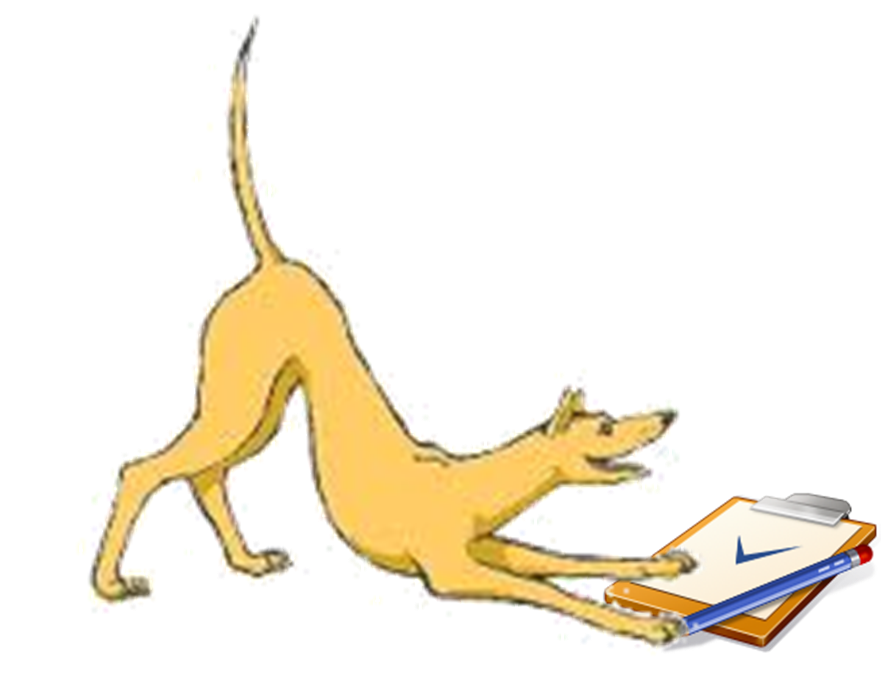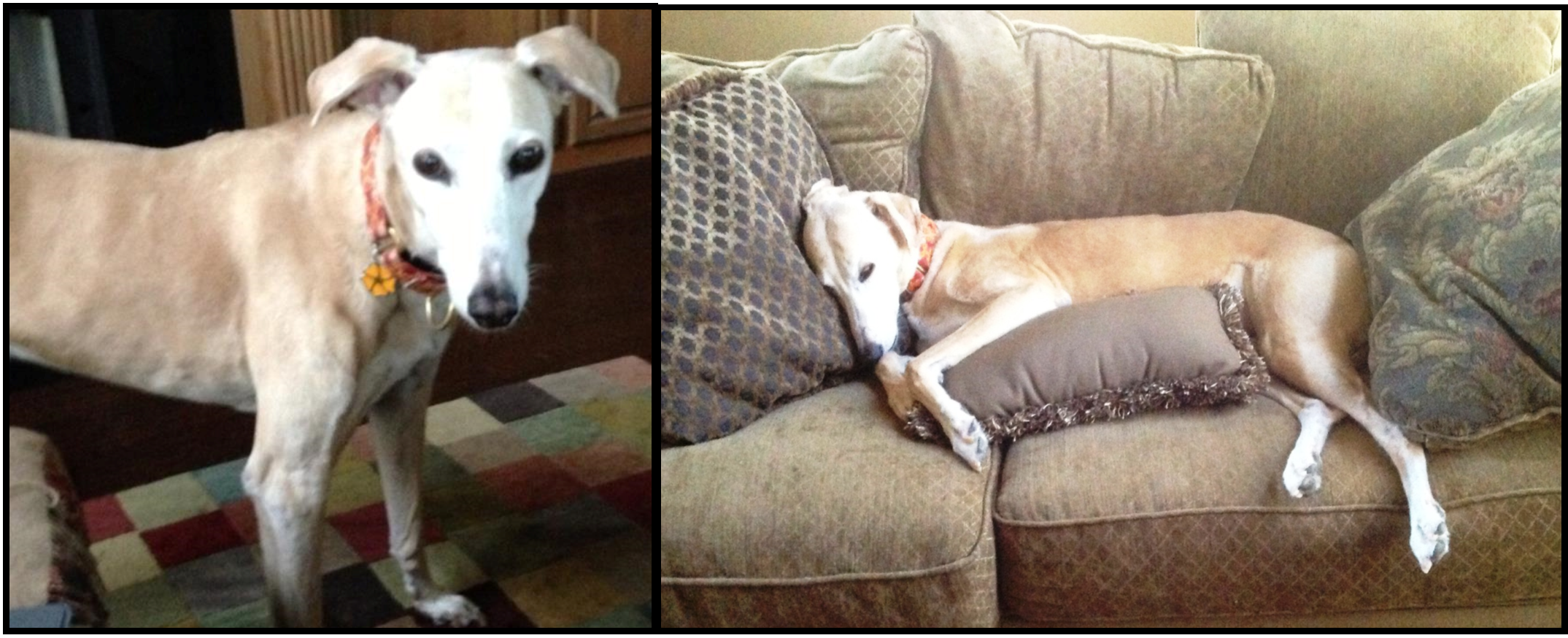Did you know...


Rake leaves into billowy piles for your dog to jump into – you might want to join in – then rake them and do it again.
Lakes and streams can contain algae that can be deadly for dogs and cats. Learn about this problem. Don’t let your dogs run into ponds, lakes or streams unless you know it is safe. It is also best not to let them drink the water. Take fresh water and a portable bowl with you.
In the fall, fall color hot spots abound. Google l”fall foliage” for your area, then hit the road, co-pilot in the car and camera at hand. Check the Internet for dog-friendly hotels throughout the country as well as outdoor adventures you and your Greyhound can take together. Take a road trip with your Greyhound.
Give doga (Yoga for dogs) a try. Look for classes in your area or get out your yoga mat and do a few downward-facing dogs with your in-house dogini.
Use the four P’s to remember key things to do in case of a weather emergency: Prepare, Places, Partners and Plug:
Prepare
Develop a plan and communicate it to family members and others who need to know.
Post a Rescue Alert Pet Sticker so rescue personnel can find your pets.
Keep your pet current on vaccinations and have a copy of the records available.
Have your pet wear a collar and identification tag and consider microchipping.
Have a recent photo of you and your pet for identification.
Learn pet first aid and pet CPR. Check the Red Cross website to find classes.
Build and keep a pet disaster kit up to date.
Download checklists and pet emergency preparedness apps.
Keep emergency documents in waterproof packaging.
Places
Identify a safe haven at your home in case you need to shelter in place.
Keep a current list of pet-friendly motels near and far. Find out in advance if they will accept the kind of pet you have.
Have a crate or carrier for each pet with their name, your name and photo of the pet.
Partner
Collaborate with other pet owners to plan to care for each other’s pets I case of emergency.
Plug
Communicate your plan to all family members.
Know the warning and alert systems in your community. Pay attention to alerts.
Do not delay actions. Leave early if you need to go.
If you need to go to a public shelter, pets may not be allowed, so it is important to have other options for them and include this in your disaster plan. Check to see if your city’s Office of Emergency Management includes information on family disaster preparedness, including pet preparedness and a checklist of supplies for your pet emergency kit. Also check the ASPCA website for more information on creating a pet emergency plan and get a free “in case of fire or emergency evacuation sticker” to alert first responders that you have a pet.
With thunderstorms, flash flooding, tornadoes, and hurricanes (depending on where you live) come thoughts of emergency planning for you and your pet. The likelihood of you and your pet surviving a weather or other emergency depends on prior planning. If you have to evacuate, take your pets with you. First responders could be put at risk when confronted by a frightened animal left behind.
If you need to go to a public shelter, pets may not be allowed, so it is important to have other options for them and include this in your disaster plan. Check to see if your city’s Office of Emergency Management includes information on family disaster preparedness, including pet preparedness and a checklist of supplies for your pet emergency kit. Also check the ASPCA website for more information on creating a pet emergency plan and get a free “in case of fire or emergency evacuation sticker” to alert first responders that you have a pet.
Greyhounds love to please. Enroll your Greyhound in an obedience class or agility course and have some summer fun.
That you should bathe your dog once every three months or as you feel is needed. However, bathing too often dries out a dog’s skin and coat. Only use a shampoo made for dogs. If your dog has sensitive skin or an allergic skin condition (as some Greyhounds do), purchase a shampoo designed for these health issues.
That you should brush your dog’s teeth once every two or three days, using a soft toothbrush or gauze with dog toothpaste (Yum, poultry flavor!!). Rub the teeth and around the gum line. Also consider giving your dog dental chews that mechanically remove food particles and plaque as your dog chews to keep his teeth clean between brushings.
That you should cut your dog’s nails about once every two weeks. Use sharp clippers and cut nails from top to bottom, rather than from side to side. If your dog’s nails are white, you can see the pinkish spot indicating the vein. Do not cut into the vein. If the nails are black, make small cuts and look at the tip of the nail straight on; when you see a pale oval in its center, you’re near the vein, so stop cutting. Apply styptic powder (or corn starch) to stop the bleeding if you cut the vein. Your dog will be happier with short nails (and you won’t hear the clicking on hard floor surfaces).
For thousands of years greyhounds have been bred to hunt by outrunning their prey. They were not intended to be solitary hunters, but to work with other dogs. Switching from hunting to racing has kept this aspect of their personality very much alive. The fastest breed of dog, greyhounds can reach a top speed of 45 miles per hour, and can average more than 30 miles per hour for distances up to one mile. Selective breeding has given the greyhound an athlete's body with the grace of a dancer. At the same time, the need to anticipate the evasive maneuvers of their prey has endowed the Greyhound with a high degree of intelligence.
The greyhound has a long neck and head, with a barely noticeable stop, or bridge to his nose. The ears are small and usually folded flat back against the neck. Their ears have a variety of poses, from straight up, to laid back flat against their neck ("rose bud" ears), to semi-pricked ears like a Collie's.
The back is long and muscular with an arch over the loin. The deep chest and narrow waist give the greyhound its distinctive silhouette. The legs are long and powerful. The feet are small and compact, with well knuckled toes. The tail is long and curved.
The coat of a greyhound is short and smooth. Greyhounds come in an endless variety of colors, including white, fawn (tan), red (rust), black, blue (gray), many shades of brindle, and with patches of these colors on white. At right is a "blue" greyhound, proving that greyhounds can in fact be gray. Their most common color is brindle, black tiger stripes on a lighter background. The most common brindle is fawn, and most have a black mask. Their coat length differs from dog to dog, and some will have a thicker, teddy bear coat while others have a short, slick coat with just some feathering on the buttocks. They have virtually no body fat. In general, greyhounds are very clean and do not require a lot of grooming.
Three separate breeding lines exist: racing, coursing and show greyhounds. Racing greyhounds are bred for speed, coursing greys for a combination of speed, endurance, and courage, and show greys for appearance. A show greyhound typically stands 26-30 inches at the shoulder and weighs 60-85 pounds. Bitches average around 10 to 15 pounds less. The average lifespan is twelve to sixteen years. Track greyhounds are usually 25-29 inches and 50-80 pounds. The AKC standard specifies 65-70 pounds for males, 60-65 for females as ideal. The modern coursing dog is 20 percent heavier than his ancestors 30 years ago. Modern track dogs are considerably more flat-sided than the greyhounds of pre-modern coursing days.




Texas Adopt a Greyhound Society, Inc. ~ P.O. Box 703782 ~ Dallas, TX 75370 214-368-TAGS(8247)